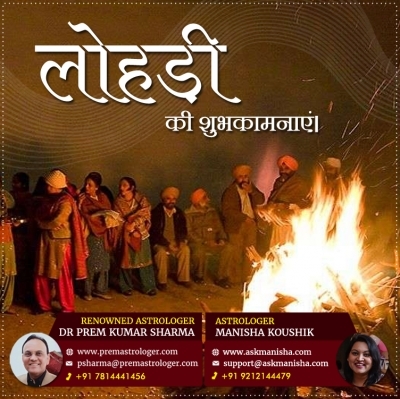
Lohri :-
Legend Brief:
Lohri Festival is celebrated with great pomp in North India. At this time Earth starts moving towards the sun marking the auspicious period of Uttarayan. First Lohri is very important for the newly wed and the new born babies as it marks fertility. This festival is related to harvest season. Punjab being a predominantly agricultural state that prides itself on its food grain production, it is little wonder that Lohri is its one of the most significant festival. Thus, Lohri is symbolic of ripening of the crops and of copious harvest.
Though Lohri festival has no religious significance but it
holds a great social significance and is celebrated as a day of imparting
social love to one and all. The festival of Lohri is meant to relieve people
from worldly day to day routine, and make them relaxed, cheerful and happy. It
is the time when people from all castes and social strata come together
forgetting all past differences and grievances. Every year Lohri succeeds in
bridging the social gap, as people visit homes, distribute sweets and greet
each other.
Apart from this, the festival of Lohri is related to the harvest season.
Harvest and fertility festivals a special significance for an agrarian country
like India. Punjab being a predominantly agricultural state that prides itself
on its food grain production, it is little wonder that Lohri is its one of the
most significant festival. Thus, Lohri is symbolic of ripening of the crops and
of copious harvest. Lohri instill sensitivity among the people towards their environment
and culture. The fundamental theory behind the festival of Lohri is the sense
of togetherness and the culturally rich legacy of the people of Punjab.
Lohri in Punjab and Haryana have always been celebrated with much exuberance
and fanfare. They believe in celebrating this harvest festival together and
rejoicing it to the fullest. For the masses this festival is a popular occasion
for social intercourse and enjoyment. They make a bonfire and roast 'fresh
chholia' (green gram) in pods with its leaves and stems intact, and eat it.
They also sing and dance sitting around the fire. Lohri is thus a community
festival and is always celebrated by getting together with neighbors and the
relatives.
The focus of Lohri is on the bonfire. The traditional dinner with makki ki roti
and sarson ka saag is quintessential. The prasad comprises of five main items:
til (gingelly) ,gajak (a
hardened bar of peanuts in jaggery or sugar syrup) , gur (jaggery) , moongphali
(peanuts) , and phuliya (popcorn). There is puja, involving parikrama around
the fire and distribution of prasad. This symbolises a prayer to Agni, the
spark of life, for abundant crops and prosperity.
Therefore, the festival of Lohri has great social significance. This time is
considered auspicious for marriages and to undertake new ventures. The farmer,
comparatively free from his yeoman's duties, takes to fun and frolic. The
golden color of the ripening corn in the fields pleases him. For newly-weds and
newborns, Lohri is a special occasion. Families of the bride and groom get
together and celebrate by dancing around the fire and expressing their joy.
Lohri is a grand event of social and cultural integration, bringing about unity,
amity, harmony among all castes and communities.
Sunder mundriya ...ho
Tera kaun vichara...ho
Dulla Bhatti wala ...ho
Dulle ni ti Viahiyi...ho
Saer Shakar Payi ...ho
Kudi de Boje Payi...Ho